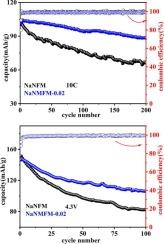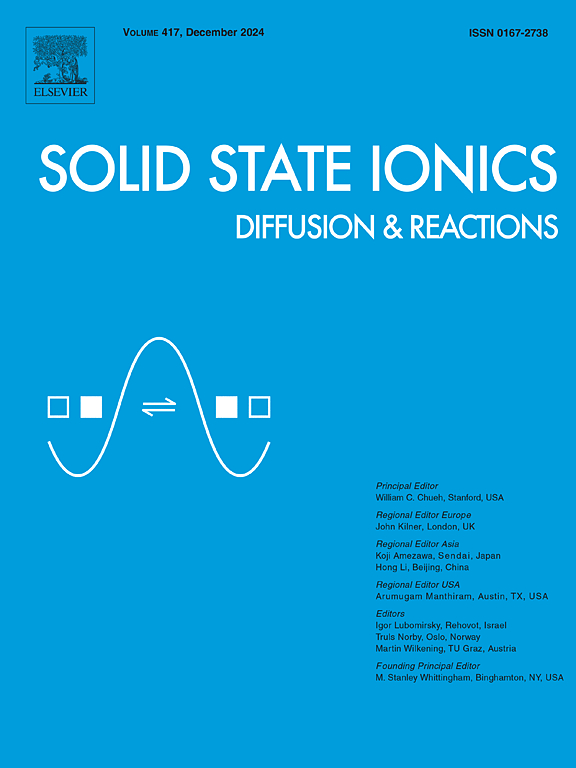Effect of the position of Mg replacing Ni on O3-NaNi1/3Fe1/3Mn1/3O2 on the structural stability of cathode materials
IF 3
4区 材料科学
Q3 CHEMISTRY, PHYSICAL
引用次数: 0
Abstract
O3-NaNi1/3Fe1/3Mn1/3O2 (NaNFM) materials are susceptible to complex phase transitions during electrical cycling leading to poor structural, capacity retention and multiplicity properties. These drawbacks hinder the application of NaNFM in sodium-ion batteries. Here, Mg2+ with larger ionic radius was used to dope its transition metal layer Ni site. The effects of Mg2+ doped NaNFM crystal structure and transition metal valence states on its electrochemical properties were investigated by XRD, SEM, and XPS. The capacity retention of NaNMFM-0.02 (84.05 %) was higher than that of NaNFM (73 %) after 200 cycles of the material at 5C. In addition, NaNMFM-0.02 achieved a first discharge specific capacity of 146.5 mAh/g at high voltage. Based on structural and electrochemical analyses, this improvement is attributed to the fact that magnesium acts as a “pillar” to stabilize the crystal structure of NaNFM, while magnesium doping reduces the Jahn-Teller effect. As a result, the material has better electrochemical properties.

镁取代镍在 O3-NaNi1/3Fe1/3Mn1/3O2 上的位置对阴极材料结构稳定性的影响
O3-NaNi1/3Fe1/3Mn1/3O2(NaNFM)材料在电循环过程中容易发生复杂的相变,导致结构、容量保持和倍率特性不佳。这些缺点阻碍了 NaNFM 在钠离子电池中的应用。在这里,采用了离子半径较大的 Mg2+ 来掺杂其过渡金属层 Ni 位点。通过 XRD、SEM 和 XPS 研究了掺杂 Mg2+ 的 NaNFM 晶体结构和过渡金属价态对其电化学性能的影响。在 5C 下循环 200 次后,NaNMFM-0.02 的容量保持率(84.05%)高于 NaNFM(73%)。此外,NaNMFM-0.02 在高电压下的首次放电比容量达到了 146.5 mAh/g。根据结构和电化学分析,这一改进归因于镁作为 "支柱 "稳定了 NaNFM 的晶体结构,同时镁的掺杂降低了 Jahn-Teller 效应。因此,该材料具有更好的电化学特性。
本文章由计算机程序翻译,如有差异,请以英文原文为准。
求助全文
约1分钟内获得全文
求助全文
来源期刊

Solid State Ionics
物理-物理:凝聚态物理
CiteScore
6.10
自引率
3.10%
发文量
152
审稿时长
58 days
期刊介绍:
This interdisciplinary journal is devoted to the physics, chemistry and materials science of diffusion, mass transport, and reactivity of solids. The major part of each issue is devoted to articles on:
(i) physics and chemistry of defects in solids;
(ii) reactions in and on solids, e.g. intercalation, corrosion, oxidation, sintering;
(iii) ion transport measurements, mechanisms and theory;
(iv) solid state electrochemistry;
(v) ionically-electronically mixed conducting solids.
Related technological applications are also included, provided their characteristics are interpreted in terms of the basic solid state properties.
Review papers and relevant symposium proceedings are welcome.
 求助内容:
求助内容: 应助结果提醒方式:
应助结果提醒方式:


